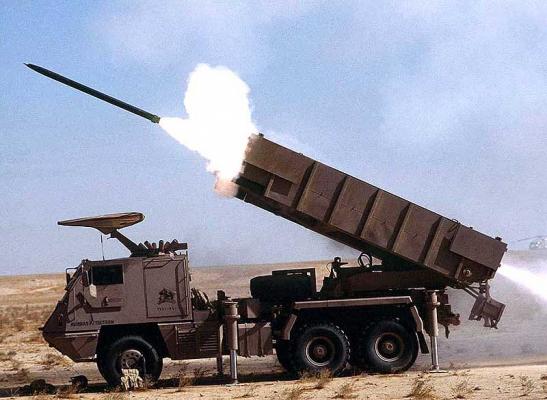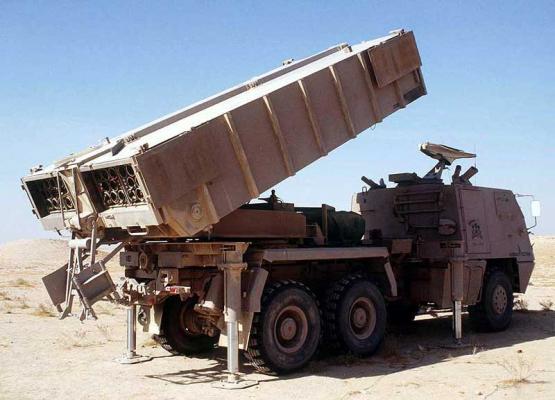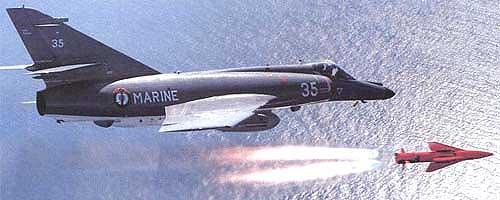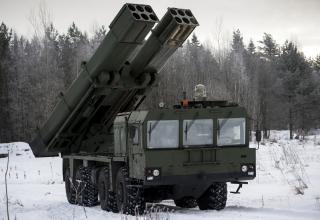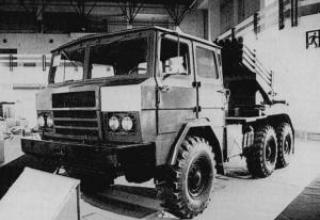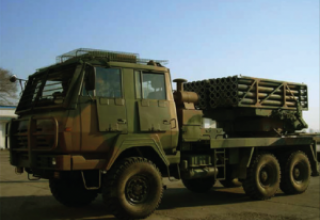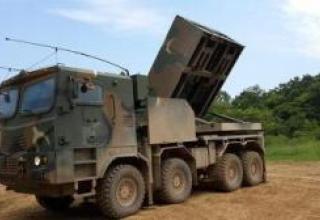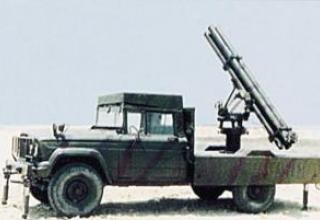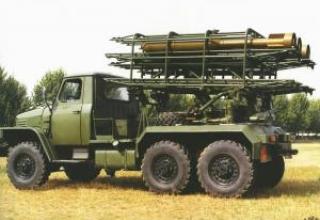Astros II is designed and manufactured by Avibras Aerospacial S.A. (Brazil) . The deliveries of the Astros II MRF system started in 1983. A number of fundamentally new technical solutions, embodied in the design of the rocket projectile, allows us to classify it to a completely new generation of weapons of this kind.
It was adopted for service in 1983. It is currently in service with the land forces of Brazil, Iraq and Saudi Arabia. It was actively used during the operation "Desert Storm" in 1991 in Iraq against the U.S. armed forces, fighting the Brazilian army.
Astros II MLRS is distinguished:
- - High mobility security of all systems;
- - High density of fire;
- - Availability at any time of day or night;
- - High missile accuracy and efficiency;
- - Homing of the guide package without leaving the cockpit.
A variant of equipping the Astros II with a tactical missile with a range of up to 150 km, which can be equipped with different types of head units, has been developed.
Composition:
Astros II MLRSs include the following combat vehicles:
Universal AV-LMU launcher, capable of firing 5 types of missiles of different calibers;
- AV-RMD Transport and Charging Machine (TZM), which at full load can carry 2 containers of rockets for each launcher;
- Jet projectiles ;
- Command Vehicle (AV-VCC) designed to provide communication, data transmission and fire control of three Astros-2 batteries;
- Mobile workshop for repair and maintenance;
- Automated Guidance and Fire Control System (AV-UCF), the main purpose of which is calculation of firing settings and flight task data.
All combat vehicles are mounted on three-axle cross-country chassis with carrying capacity of 10 tons, wheel arrangement 6x6. The trucks have a diesel engine "Mercedes-Benz" with an output of 280 hp and can move at speeds up to 90 km/h.
In the front part of the AV-LMU launcher, an armored wheelhouse is mounted on the chassis frame, which accommodates the commander of the PU, the mechanic-driver and the gunner. In the isolated compartment of the cabin there is a power plant and transmission units. Artillery part of the PU is made according to the modular scheme and is a box farm, which can be installed four interchangeable transport and launch containers with bags of tubular rails. Variants with different number of guides in the container are produced. The number of guides depends on the type of jet projectiles used. In this way, the launcher can be a basic element for the development of rocket systems of different military units. Reloading is carried out by means of a transport and charging machine by replacing the transport and launching containers that are equipped in the factory. The container replacement time is 5-6 minutes.
The guidance package is guided by rotary and lifting mechanisms with power drives. Management of all operations on preparation and conducting shooting is carried out from the control desk in the armored cabin. Input data for firing are calculated with the help of the computing device of the control desk or transferred from the command post.
The auxiliary armament of the launcher consists of a 12.7 mm anti-aircraft machine gun mounted above the hatch in the cabin roof. The launcher is equipped with radio communication and navigation equipment. Firefighting equipment and night vision equipment are available.
Rocket projectiles
To improve the accuracy of firing, the Astros II rocket launchers are equipped with a flight control system that corrects the pitch and yaw trajectory. Pitch and yaw correction, carried out according to the control system signals, is performed by the gas-dynamic executive body - gas-dynamic rudders, which are driven by high-pressure gas from the onboard gas generator.
Types of rockets:
- SS-30 of 127 mm caliber with a firing range of 30 km (32 rails);
- SS-40 caliber 180 mm with a firing range of 35 km (16 guides);
- SS-60, 300 mm caliber, with a firing range of 60 km (4 rails);
- SS-80 caliber 300 mm with a firing range of 80 km (4 guides).
Three types of cluster warheads have been developed for the rockets:
- - shrapnel-like;
- - cassette cluster with cumulative shrapnel warheads (CSBEs);
- - cassette cluster with anti-tank antipersonnel mines;
The combat unit of the SS-40 missile contains 20 COBEs, the combat unit SS-60 has 65 COBEs, the combat unit SS-80 has 52 elements. To destroy runways of airfields, projectiles can be equipped with penetration-type combat units. Due to the delay in detonation, such a projectile penetrates the ground to a depth of 0.5 metres.
The Astros II RSW battery includes: six AV-LMU universal launchers, six AV-RMD TMs, and the AV-UCF control and guidance system. The AV-VCC command machine, together with two mobile workshops, is given to the battalion.
Characteristics:
| Astros II RDC | |
| Fighting vehicle | AV-VBA 6 x 6 |
| Base | Mercedes-Benz 280 |
| Maximum speed, km/h | 90 |
| Recharging time, min | 10 |
| Calculation, man. | 4 |
| Year of adoption | 1983 |
| SS-30 Jet Projectile | |
| Caliber, mm | 127 |
| Quantity in the container, pcs. | 32 |
| Weight, kg | 68 |
| Length, m | 3,9 |
| Range, km | 9-30 |
| Jet projectile SS-40 | |
| Caliber, mm | 180 |
| Quantity in the container, pcs. | 16 |
| Weight, kg | 152 |
| Length, m | 4,2 |
| Range, km | 15-35 |
| Jet projectile SS-60 | |
| Caliber, mm | 300 |
| Quantity in the container, pcs. | 4 |
| Weight, kg | 595 |
| Length, m | 5,6 |
| Range, km | 20-60 |
Testing:
During Operation Desert Storm in 1991, French Jaguar aircraft used AS-30L, which was normally launched from the aircraft during a 1.3 km dive (2.2 km entry altitude). A container with Atlis-2 target designation system was used for laser illumination of targets, suspended on a sub-basement pylon. A video was shown to the press depicting the AS-30L missile hitting a fortified ammunition depot, flying into its premises through the right gate door. In total, about 60 missiles were fired during this operation, the number of hits was 97% (according to other data 80%). According to French pilots in the Middle East theatre of war, they began to record ground targets at a distance of 16-20 km using the television system of the upgraded Atlis-2 container.
During NATO's air aggression against Yugoslavia in 1999, French Super Etendart fighter jets struck targets in Serbia (mainly in the western and southwestern parts of the country), attacking army and paramilitary police units while providing advanced aircraft pointers (AFAC), whose functions were taken over by American tactical F-16C fighters. The combat missions were conducted by pairs of aircraft - one aimed at the target using the Atlis-2 laser system, while the other struck by AS-30L missiles or laser-guided 500-pound GBU-12 bombs.
